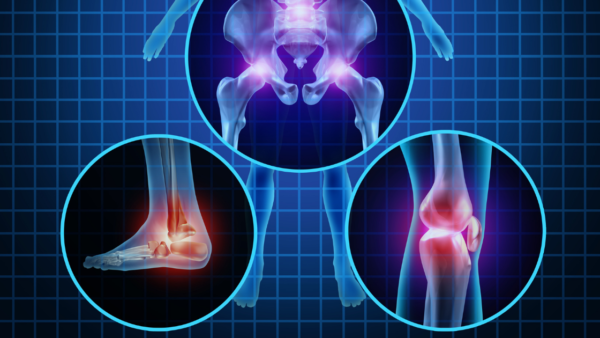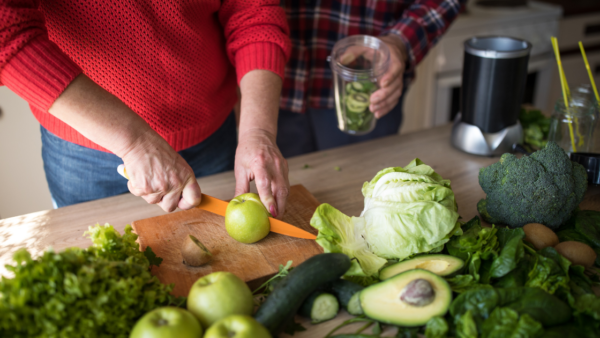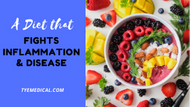How to Reclaim Your Health with an Anti-Inflammatory Diet Plan
Dec 18th 2020
Are you feeling tired, achy, and having gastro symptoms like constipation, diarrhea, or acid reflux? You might have chronic inflammation, which is especially likely if your doctor has ruled out other conditions. While you can attack inflammation from various angles, an anti-inflammatory diet plan is key to successful healing.
As you start a new year, consider how a diet designed for your health can also trim your waistline and keep your hunger satisfied. You can expect to drop a few pounds while focusing on low-carb, whole-grain foods and little sugar.
 Why Inflammation Is a Bad Thing
Why Inflammation Is a Bad Thing
Sometimes inflammation is useful (acute inflammation) because it helps your body fight infections, injuries, and even illnesses. Your inflammatory response boosts the production of immune cells, white blood cells, and cytokines. When the reaction is warranted or short term, then inflammation is like a hero coming to the rescue.
But sometimes, your awesome disease-fighting defense system goes on the warpath when you aren’t sick or injured. When it lingers for months or years, it’s called whole-body or chronic inflammation and might develop into more long-term autoimmune disorders.
But why would this happen? With chronic inflammation, something in your body is triggering the immune response falsely. Whatever the cause – your body believes it is in distress and sends out the calvary – the white blood cells and their compadres go on defense, sometimes attacking healthy tissue nearby.
Most of the time, you won’t know you’re under attack and experiencing whole-body inflammation in any obvious way. It often presents as an accumulation of common symptoms that are attributed to age or other health conditions.
How Chronic Inflammation Affects General Health
It’s best to address whole-body inflammation as soon as possible through an anti-inflammatory diet plan and other lifestyle changes. Over time, it progresses to other conditions and is considered the gateway to autoimmune disorders such as type 1 diabetes, lupus, and rheumatoid arthritis.
It’s also been linked to age-related diseases like Alzheimer’s and Parkinson’s. But even more surprising is the connection between chronic inflammation and cancer. Scientists confirm this long-held suspicion, noting that cancer develops where chronic inflammation has done the most damage. For more information about the extreme impact chronic inflammation can have on your health, check out our article How Does Chronic Inflammation Affect Your Health?
Your doctor can run some tests to determine your level of inflammation. However, almost anyone can benefit from reducing inflammation and following an anti-inflammatory diet plan.
How Does Inflammation Affect the Bladder?
Since chronic inflammation is often widespread, sometimes even the bladder or kidneys become inflamed or irritated – known as cystitis. This causes various symptoms, not unlike a bladder infection. You might experience more pain and pressure in your lower abdomen that intensifies when you need to urinate. You might even notice some mild to moderate leaks and increased urinary frequency.
When inflammation is more acute, it can cause a burning sensation when you pee. Be sure to ask your doctor for a urine culture to determine if bacteria are present. This will indicate whether the pain is due to an infection or other causes.
Often, cystitis symptoms come and go in response to your heightened immune system or something you consumed. But when cystitis becomes chronic, lasting for six months or more, it’s typically considered bladder pain syndrome (BPS) or interstitial cystitis (IC). For details about this condition (and foods to avoid), see our article, A Brief Guide to Interstitial Cystitis.
You can modify an anti-inflammatory diet plan to exclude foods that irritate a bladder prone to inflammation.
How Diet Affects Inflammation
Dr. Andrew Weil, founder and director of the Center for Integrative Medicine at the University of Arizona, believes that an anti-inflammatory diet plan is the most important thing you can do to reduce whole-body inflammation.
He formulated a detailed and whole-foods-based plan for fighting inflammation. It focuses on eliminating refined, processed, and manufactured foods while drastically reducing red meat, poultry, dairy, and sugar consumption.
How does this help?
The healthy eating plan reduces or eliminates foods like refined carbs, sugar, dairy, and red meat that frequently trigger your immune system to attack. Likewise, the diet encourages you to eat more plant-based protein, whole grains, fresh fruit, and fresh vegetable. These foods fight inflammation and calm your immune response.
Anti-Inflammatory Diet Plan Outline
Here’s an overview of Dr. Weil’s healthy eating plan to fight inflammation. For more detailed information on what to eat (and what not to eat), check out his comprehensive anti-inflammatory food pyramid.
Vegetables (4-5 servings daily)
Consider this a plant-based diet with vegetables and fruit being the foundation. Incorporate both raw and cooked vegetables into your diet, and feel free to get creative. Try sautéing or roasting them in healthy oil. Just avoid adding dairy or unhealthy ingredients. Here’s a link to some of Dr. Weil’s veggie recipes.
Fruits (3-4 servings daily)
Like vegetables, fruits are packed full of flavonoids and carotenoids, two high-powered phytonutrients with antioxidant and anti-inflammatory properties. They help protect against diseases like cancer, cardiovascular diseases, and neurodegenerative diseases.
Dr. Weil recommends buying fresh or frozen organic produce when you can. Chemicals used in non-organic farming can contribute to inflammation.
Beans and Legumes (1-2 servings per day)
Beans and lentils are a source of both protein and healthy carbohydrates. You can toss them into a meal-bowl with some brown rice and veggies, add them to a soup, or puree them into a spread or side dish. They deliver a healthy dose of soluble fiber along with folic acid and magnesium.
Pasta (al dente, 2-3 servings weekly)
It’s critical to note the serving size and frequency when including pasta in your anti-inflammatory diet plan. It’s 2-3 servings weekly, and one serving is equal to a rounded ½ cup. So, while you can have some pasta and keep inflammation at bay, large plates of pasta are off the table (pun intended) when it comes to healthful eating.
It’s also best to choose pasta that’s not 100% white wheat flour. Many alternatives line the shelves today. And be sure to cook it al dente, which means that it’s not mushy and still requires a little chewing. Overcooking pasta increases its starchiness.
Whole and Cracked Grains (3-5 servings daily)
Again, it’s best to choose less refined options like brown rice, basmati rice, buckwheat groats (naturally gluten-free), barley, or quinoa (also naturally gluten-free). While oats are a great option, Dr. Weil recommends less refined steel-cut oats. They take longer to cook, but you can usually find quick-cook options in some stores and online.
While some refined products like whole-wheat bread contain processed whole grains, it’s not a substitute for eating the actual whole grains just listed.
Healthy Fats (5-7 servings per day)
You probably know it’s best to limit or eliminate foods rich in saturated fat (like butter, for example). The anti-inflammatory diet plan encourages the use of monounsaturated fats (olive oil and grapeseed oil) and omega-3 fats (nuts, avocados, seeds). When possible, opt for “expeller pressed” versions of these oils that are processed without chemicals. Healthy fats lower bad LDL cholesterol and triglyceride levels and reduce the risk of heart disease and stroke.
Dr. Weil’s healthy eating plan urges you to avoid corn oil, cottonseed oil, and mixed vegetable oils, as well as margarine, vegetable shortening, and anything with these ingredients. For more information on the various types of cooking oils, check out this article from Time.com, The 10 Best and Worst Oils for Your Health, that offers a thorough overview.
Fish and Shellfish (2-6 servings per week)
The best way to get healthy doses of omega-3 fats is to eat fish like wild Alaskan salmon, black cod (sablefish), herring, sardines, etc. Or, if you’re not a seafood lover, a fish-oil supplement also works. Just be sure you’re getting both EPA and DHA and at least 2 to 3 grams per day.
Omega-3 fatty acids are champions when it comes to battling inflammation and preventing autoimmune diseases. They block the production of substances that trigger your immune system and inflammation.
Whole-Soy Foods (1-2 servings per day)
Note that the recommendation is for whole soy foods. Many processed soy products (protein powders, imitation meats, and some soy milk types) are made with soy protein isolate, a stripped-down version with none of the fat, fiber, or carbs containing most of the health benefits.
Think of soy protein isolate as the processed white flour of the plant-based protein world. Additionally, this lesser version of soy has been known to play a part in hormonal imbalances ( mimicking estrogen).
But there’s no need to avoid whole soy products like tofu, tempeh, edamame (soybeans), soy nuts, or milk made from whole soy (check the label). Soy is a plant-based protein that fights inflammation and contains antioxidant properties to help protect against cancer.
Other Sources of Protein (1-2 servings per week)
This is where it gets tricky for some people. So, what is “other” protein?
- Dairy
- Eggs
- Poultry
- Lean meats (grass-finished)
All these foods that most Americans and Westerners eat multiple times per day are recommended only once or twice per week. This means you must choose if you want a cup of yogurt or a strip of grass-finished steak (from cows fed only grass and forage food their entire lives). Unless they are to be your two servings of other protein this week – you can’t have both.
The challenging truth: it’s best to seriously reduce your consumption of animal products – for your health. Overconsumption and the problematic processing methods make these foods a serious inflammation trigger. And as we know, this leads to many other illnesses. For more information about a plant-based diet (like the anti-inflammatory diet plan), check out our article.
 Who Should Follow an Anti-Inflammatory Diet Plan?
Who Should Follow an Anti-Inflammatory Diet Plan?
Truthfully, everyone should follow some variation of this plan. Some nutritionists recommend the Mediterranean diet plan as an alternative, although it’s less powerful in fighting inflammation. But it still focuses on plant-based eating, fresh produce, whole grains, and more seafood – all of which can help reduce inflammation.
Choose the variation that works best for you. The important thing is to start somewhere. Maybe you begin by eliminating more processed foods from your diet and limiting sugar. You can also start adding more soy or seafood to your diet.
If you’re ready to take a big step toward a healthier you, then start following an inflammation-fighting diet plan tomorrow or next week. You will see a difference in your health. Just give it some time.
In the meantime, if you’re battling episodes of cystitis, IC, and related bladder leaks, you’ll need reliable, comfortable, discreet products to keep stress to a minimum. For lighter leaks, order a box of our Ultra-Thin Pads.
For heavier leaks, try our Protective Underwear (and check out our two-piece system).


